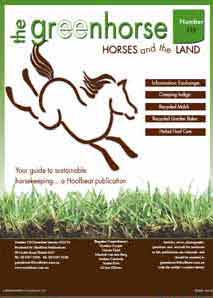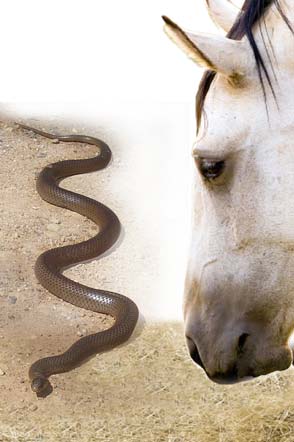The Green Horse section provides practical information on managing environmentally sustainable horse properties, readers stories and tips, as well as advice and articles from equestrian experts in their fields.
December January 2019/20
Vol 41 No 4
In this issue of The Green Horse you will find the following articles:
Keeping Snakes out of the Stable by Wendy Elks
So, what can you do to deter snakes
from residing in your stables?
Are Fungal Wormers the Future for Horses and Pasture?
Resistance by worms to conventional dewormers sparked an Australian study to evaluate the efficacy of using nematophagous fungi as a non-chemical deworming strategy in 2018.
Deeds Steeds and Weeds
Accident Proof you Stable Area
If you’re considering starting 2020 as organised as you can be in the stables, here’s a few things you can do to create a safer and more welcoming environment without breaking the bank.
Weed Free and Fire Ready by Mark Brown
. . . does it all come down to prior preparation?
Beware Rabbits
Horse owners should be concerned about rabbits as their burrows undermine pasture and are ‘accidents waiting to happen’ for horses in the paddock and on trail rides.
WIN A YEAR'S SUBSCRIPTION...
share your equine property management tips and each issue one reader will win.
Send ideas to -
The Green Horse Support <greenhorse@hoofbeats.com.au>


PREVIOUS ARTICLES
Available on line
ON19 - TERMITE S- common myths
by Rhiannon Brown, Envirapest
Your house and stables are looking wonderful this spring, but do you know what is happening inside the walls of your brick or timber building?
AS19 - OUCH THAT HURTS
by Catherine Bird for Country Park Saddlery
The extent of the swelling is usually an indication of the severity of the infection or injury and the cause needs to be established before giving herbs.
JJ19 - MANAGING PASTURE
by Rhiannon Brown, Envirapest Healthy pasture means healthy horses.
A/M19 - STOP THOSE WEEDS
Property biosecurity
by Rhiannon Brown, Envirapest
Putting simple precautionary steps into place can make it tough for weeds to get a hold on your equine paradise.
|
  
  


Keeping Snakes Out of the Stable
by Wendy Elks
Snakes may be protected under Wildlife regulations in Australia, and they may be great for keeping the mice and rats down, but do we want to find them in our stables near our horses and pets?
Australia is home to some of the most venomous snakes in the world. Occurring naturally across the continent, they live solo and are territorial, so seeing the odd snake about is not unlikely in the warmer months, as they move around looking for food, water, or a mate. Snakes are protected by law in all states and territories of Australia and may not be killed unless they threaten life, but they are not desirable on a horse property, though they prey on far more prolific pests like mice and rats.
Snakes are shy, mostly non-aggressive (unless challenged) and prefer to escape unseen, but they pose a threat to humans, pets and stock. Detecting movement through the ground and air, they generally move away when they sense something approaching, especially heavy, flat-footed horses.
A stable complex where rodents flourish will attract snakes looking for a meal and there are many places they can then retire to digest it as invariably there is hay, rugs, feed bins, and washing machines, which are ideal spots for snakes to hide.
Long grass in ditches, dams and storm drains are other attractive habitats.
So, what can you do to deter snakes from residing in your stables?
IN THE FEED ROOM
• Reduce rodent numbers wherever possible by removing food sources and hiding places.
• Keep all horse handling, feed and storage areas swept clean.
• Store all feeds and everything edible in rodent-proof bins and mouse-proof containers.
• Immediately remove spillages and keep hay sheds well swept.
• Beware pallets holding hay; while wonderful for keeping hay off the ground they offer ideal dark, dry spaces underneath.
• Consider erecting snake-proof fence around stable area.
IN THE STABLE COMPLEX OR SHEDS
• Store items on shelving rather than the floor. Clear away and tidy rugs, plant pots, and horse, garden and shed clutter, where rodents can shelter.
• Straw may not be the best choice for stabling during summer as snakes easily disappear into it.
• Where possible, seal doors with rubber edging or weather sealer so rodents and snakes can’t easily enter.
OUTSIDE THE STABLES
• Keep compost piles away from horse areas and the house, and turn them regularly. Avoid putting egg shells and other foodstuffs in open compost, which attracts rats.
• Leaving pet food out attracts rodents. Poultry and their feeds also attract rodents. Keep pens clean, store feeds appropriately and feed only what the birds can finish or in rodent-proof feeders. Geese are excellent guardians and will viciously attack a snake.
REDUCE SNALKE HABITAT
Clear away tin, timber, building materials, old machinery, rubbish piles and garden refuse around the property (take care as there may be a snake underneath).
Store corrugated iron sheets vertically or on shelves. Stack firewood away from stables and the house, preferably on concrete. Wear gloves, and never put your hand where you can’t see.
Keeping grass low around the house and stables not only makes it easier to spot a snake but it will make it safer in the event of a fire. Prune lower branches from shrubs and use mat-like ground covers rather than bushy ones, to reduce hiding places.
Water sources attract all kinds of animals including frogs, which are also on the snake’s breakfast menu. Keep areas around pools, ponds and dams mown and clear, wherever possible. Fence off dams to restrict access to stock and people. Leaving out water for wildlife is important, but keep it away from the house and horse areas, in an open spot where a snake can be seen.
Snakes don’t like activity and disturbance
Dogs, cats, horses, chooks, people, machinery, voices, - all help to discourage a snake, but that doesn’t mean they will never be where there is noise. Dogs can be trained to avoid snakes, as while some seem to excel in presenting dead snakes as a gift to you, there are many dogs and cats that die of snake bite each year.
Snakes may bask in the sun, or seek shade in extreme heat, and are often found in piles of leaves, so it’s easy to come across them unexpectedly. If a snake is sighted, do not disturb or go near it. Stand still, remain calm and then quietly move away. If a snake is inside a shed, stable or the house, block off escape routes and keep your eyes on the snake while someone calls a professional snake catcher. Catching and removing a snake from your property is not something that should be attempted by those inexperienced with handling snakes. There will be a fee, even if the snake isn’t caught.
Research what type of snakes frequent your area, and their habits, to know what to expect. Note that most humans are bitten while trying to catch or kill a snake. If a pet or horse is bitten seek veterinary care urgently, and if a person is bitten then immobilise the victim and call 000. Do not use a tourniquet or try to suck out venom. Modern snake anti-venom treats any snake bite, so knowing the type is not important.
The brown snake is the most common cause of snake bite, the rest occurring mostly from tiger snakes, taipans and death adders. Preparation, caution and leaving snakes alone are the best defences.
For more information visit: https://www.healthdirect.gov.au/snake-bites |